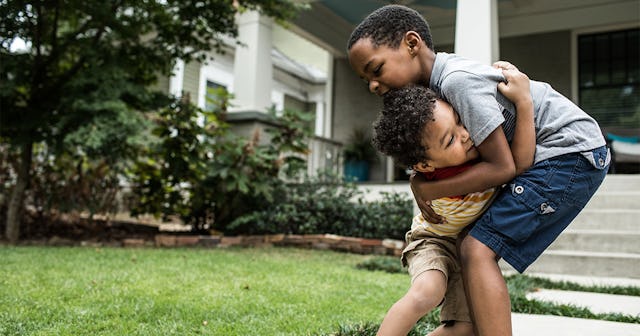Why Mixed-Age Play Is So Beneficial

Last summer it seemed like our neighborhood turned over. Each week there was a new house for sale, and during the shuffle, most of the kids my 13-year-old son played with in the streets moved away. There was, for a time, a pretty good grip of boys and girls within a year of him in age. They liked to ride bikes to the park, and shoot hoops in our driveway, and all sorts of nice Sandlot-style wholesome activities. But now, it seems like all the kids are either several years older than my son, or several years younger, and we have spent a lot of time this year wishing some kids his age would move in.
I can’t predict the future, so I don’t know if those new 13-year-old kids are ever going to move in, but just the other day an interesting post popped up on my Facebook page that got me to thinking: maybe instead of wishing for kids my son’s age to move in, what I need to be doing is encouraging him to play with children that aren’t his own age.
It was a graphic listing out the benefits of mixed-age play, many of which I’d never considered.
For example, having younger children playing with older children “enables older children to serve as a caregiver, leader, mentor…” You know, when I was 15 I started hanging out with a couple guys that were 17. I mostly just wanted to get rides places and they could drive, but over 20 years later, I realize just how much I learned from those two dudes — and they are still a couple of my best friends.
The list of benefits goes on. Older children playing with younger children can experiment with normative roles such as social hierarchy and power dynamics. Older children can challenge younger children in their development and understanding of the real world.
That last one makes a whole lot of sense. I mean, let’s be real. I try to challenge my children in their development, but most of the time they just look at me like I’m some dorky late-thirtysomething father of three, which is true. And I love my kids, but they are not going to be as inspired by me as they might be an older (and cooler) peer.
mmg1design/Getty
Going back to that example above of me hanging out with older kids: When I did learn to drive, I was afraid to try a stick shift. My grandmother wanted to teach me, but I said no because I didn’t want to push myself to do something I was scared of. Plus, my grandmother seemed old and not cool, and how much could she really teach me? I know, know — she was actually really cool and it was awesome of her to offer, but these are the kinds of decisions you make as a 16-year-old. Anyway, it just so happened that my older friend Donny had a Jeep, and the patience to show me how to drive a stick, and I pushed myself to do it simply because I wanted to impress him. Thus, obviously the above system works.
However, if you don’t want to take my word for it, perhaps you will take the word of Peter Gray, a psychologist and research professor at Boston College. He wrote a pretty interesting article about the benefits of a mixed age plan for Education Week back in 2008. According to Gray, what mixed age play generates is something called “scaffolding.”
He uses the example of a younger child playing a card game with an older child. Two younger children might not have the skills to play a card game together, because they will forget the rules. But an older child can remind the younger child how to play as they play, helping the child better learn the rules of the game.
SDI Productions/Getty
Gray goes on to say that “The benefits of age-mixed play go in both directions. In interactions with younger ones, older children exercise their nurturing instincts and take pride in being the mature person in a relationship. They also consolidate and expand their own knowledge through teaching. When older children explain rules, strategies, moral principles, or other concepts to younger ones, they have to make their implicit understanding explicit, which may lead them to re-examine what they thought they already knew.”
Of course, it isn’t always roses; there is the potential issue of older kids bullying younger kids. Yes, that can happen. But it can happen with children of the same age, too. I think the real key to avoid bullying is having good communication with your children. Ask them about their play, and who they are playing with. And if there is an issue, be sure to help them navigate it.
On the whole though, the benefits of mixed-age play are pretty awesome. Sure, it goes against the traditional education structure of placing children together due to age (although if you’re familiar with the Montessori method of education, mixed age groups are one of its primary tenets). But I must say, in regards to playing with kids in the neighborhood, I’m going to push my son to make friends with those older kids, and those younger kids. Fingers crossed, he learns something — and teaches them something in return.
This article was originally published on